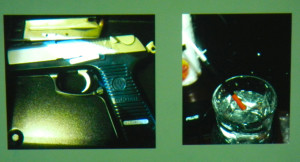Heroin near epidemic status in S. Lake Tahoe

SLEDNET agents confiscated this gun and at the same bust found a syringe in warm water to keep the heroin from solidifying.
By Kathryn Reed
Heroin is the No. 1 drug problem in South Lake Tahoe.
“It’s the biggest issue of law enforcement,” Russell Liles, a detective with South Lake El Dorado Narcotics Enforcement Team, said. “Once you do it, your biggest goal is to get more.”
It’s that initial rush that people want to keep reliving. The side effects and coming off the high are physically wrenching. It’s why people keep reaching for the next needle. Even if the user started by snorting, eventually they seem to go for an injection because reaching the state of euphoria is faster that way.
Liles on Nov. 3 spoke to the local drug coalition about the growing epidemic.
Black tar heroin is mostly what is found locally. Users are predominantly men between the ages of 18 and 25 who started the habit by first becoming addicted to prescription medication. They are doing five to 10 points a day at a cost of more $100/day.
Seldom do they have jobs because it’s near impossible to function at a coherent level being that high. Committing crime is how they pay for their heroin habit, Liles said.
But this issue isn’t new to the South Shore. Lake Tahoe News ran a two-part series about heroin in February 2012. It was the same story then – prescription opiate leads to addiction that leads to heroin. Heroin is an opiate coming from the poppy plant.
“Nearly 50 percent of young people who are injecting heroin reported abusing prescription opiates before using it,” Liles said.
Prescriptions run out, heroin is easier to get and it can be cheaper.
Liles said the people using might surprise people. Some come from good families. They had other plans for their lives. The addiction, though, became too strong.
In the last four years what Liles has noticed is more users are people one year out of high school.
The National Institutes of Health says, “Our data show that the demographic composition of heroin users entering treatment has shifted over the last 50 years such that heroin use has changed from an inner-city, minority-centered problem to one that has a more widespread geographical distribution, involving primarily white men and women in their late 20s living outside of large urban areas.”
And more people are dying from overdosing on heroin. In 2013, 8,260 people died, which is four times the number in 2000.
The local drug coalition has been focused on getting unused and expired prescription drugs out of homes. A drop off location is at the South Lake Tahoe Police Department.
The annual Drug Store Project is an all-day reality based drug education workshop for sixth-graders on the South Shore. Prescription drug use is the main component of the event.
Liles said the best thing people can do is educate young people to the dangers.
President Obama is proposing spending $133 million to increase access to drug treatment and prevention programs.
New drug laws aren’t helping the guys with the badges. Proposition 47 was passed last year by California voters. It made possession of heroin, cocaine, illegal prescriptions, concentrated cannabis, and methamphetamine all misdemeanors. Officers have the choice to arrest the person or cite him, like a traffic infraction.
If the District Attorney’s Office chooses to prosecute the case, the defendant is often out on bail or on his own recognizance until a deal is reached or the trial starts. If convicted, the person faces at most a year in county jail and even then people are often let out for good behavior.
South Lake Tahoe Police Chief Brian Uhler was an opponent to Proposition 47 before it was passed and continues to be. He has written about how it puts more criminals on the streets, which has increased some criminal activity in town.
California is not alone in rejiggering penalty guidelines. Penalties for nonviolent drug crimes were reduced by the U.S. Sentencing Commission in April 2014. Because that change could be applied retroactively, last month it was announced that the Justice Department would be releasing about 6,000 federal prison inmates who were serving time for being nonviolent drug dealers.
Liles said the reason SLEDNET doesn’t want the names used in heroin arrests is because it negatively impacts ongoing investigations.
Heroin users are a close-knit group. They don’t readily welcome others into the circle. That is why it is hard for narcotics officers to penetrate the inner sanctums, and therefore difficult to arrest the dealers.
Local heroin dealers tend to be white men between 25 and 35 years old who are able move an ounce of heroin every few days. They get their supply from Stockton, Modesto or Reno. Mexican drug cartels are turning to heroin from pot because the profit is greater. Plus, now it’s so easy to get marijuana in the U.S. without importing it and a lot of users prefer the weed that is grown indoors to outdoor cultivation.
Local heroin dealers are also unemployed. And they are often armed.
A heroin ounce is considered 25 grams, which is about 250 doses. This costs about $1,800. Dealers can turn that into about $3,750 on the street. Why they aren’t rolling in money is that they are also users. It’s not like the heyday of cocaine where dealers were flush with cash because they didn’t use the product they were peddling.